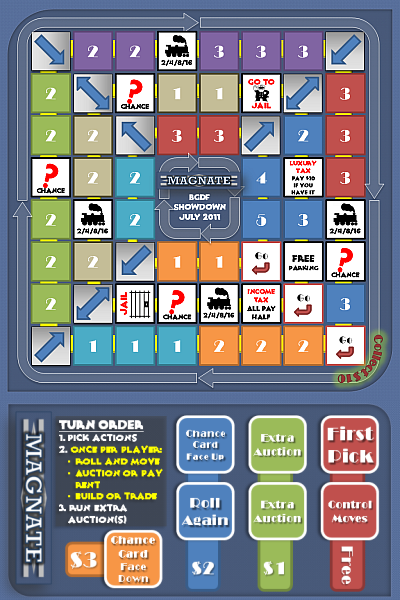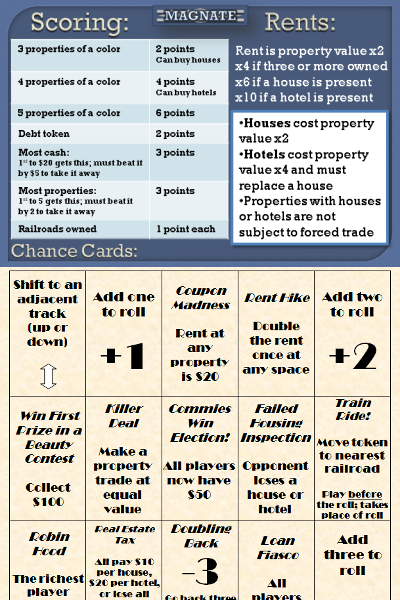July 2011 Game Design Showdown - "Europoly"
Please Read: Details on entering the Game Design Showdown.
Can you redesign a classic?
Voting on the July GDS is TOO CLOSE TO CALL!
After re-opening voting, the new votes were not much more decisive! We had a 4-way tie after Wednesday, and sadly I forgot to bring my tabulation of votes with me to Colorado (where I am now) - so I don't actually know which 2, 3, or 4 are still tied!
Sorry about the inconvenience, I'll open the critique thread so we can talk about the games anyway. For now you can assume you're all winners :)
Main Design Requirements:
Theme Restriction: Eurogame version of Monopoly
Monopoly is not very well respected nowadays among the 'elite' gamers. But without it, many gamers wouldn't be playing games today! A lot of advances have been made in board game technology since 1924, so maybe we can update this perennial "favorite" and make a proper euro-style version of the classic game Monopoly. Well, that's the challenge anyway: design a euro-style game that resembles Monopoly.Mechanics Restriction: Euro-style mechanics
Monopoly employs 4 major mechanisms: Roll & Move, Set Collection, Auctions, and Trading. In an effort to breath life into this old classic, this month's challenge requires you to replace 1 or more of these mechanisms with common/popular Eurogame mechanisms from this list, while maintaining the theme and feel of Monopoly:- Role Selection
- Worker Placement
- Area Majority
- Dice Drafting
- Deck Building
Component Restriction: Monopoly bits
Monopoly has a board, dice, property cards/tiles, Chance and Community Chest cards, player pawns, and paper money. you may use the same components, but you can change up the sizes, shapes, number, and purpose of each.
- Submissions: Wednesday, 13-July-2011 through Wednesday, 20-July-2011.
- Voting: Through Wednesday, 27-July-2011. PM your votes to sedjtroll.
- Voting Format: Each person has 6 votes to distribute any way they choose among the GDS entries with the following restrictions:
-
- You may not assign any votes to your own entry!
-
- You may not assign more than 3 votes to any single entry.
- You need not assign all 6 votes.
Comments or Questions: Comments and questions about this Challenge were handled on the Comments Thread.
- CRITIQUES: After voting has closed the entries will be posted for comments and critiques. Post constructive critiques and commentary about the entries to this Challenge in the Critiques Thread
- GDS Details: For more details on how these Game Design Showdown Challenges work, especially the details around the word count and graphics limits, visit the GDS Wiki Page.
Enjoy, and good luck!
-Seth












Monopoly - Neighborhoods
2-4 Players
8+
30-45 minutes
Components
Each player receives
50 properties tiles ( houses, malls, hotels and office buildings) showing:
Preparation
Each player takes a bag with 50 property tiles, one resource board with 5 markers, 1 pawn, 6 neighborhood tiles and 10 street tiles
Players create the map by linking the 6 neighborhood tiles via streets.
There are limitations:
Place the pawn in a neighborhood
Place markers on the resource board (at 0)
Playing the game
Every turn has three rounds
Round 1 - Roll dice, move and collect resources.
Roll dice and move along the traffic arrows. Every time players land in a neighborhood they receive:
Following a dice roll, all players move and collect resources.
Round 2 - Draw properties and place on the board
Players take turns to take one property from the bag. If they have the resources required (see Placing properties) they have two options
If a property is placed another tile can be drawn from the bag, repeat the options above.
If and only if a property drawn cannot be placed on the board due to lack of resources there are two options
Round 3 Use the Pipeline
Players that have properties in the Pipeline, count them, return them to the bag and draw am equal number of tiles. Players can (but don’t have to) place all properties they have resources for on the board. Properties not placed on the board stay in the Pipeline face down and will be use in the following turns.
Other rules
Placing properties and moving on the board
Following resources are required to place properties on the board:
When player lands next to a street he is forced to move from that neighborhood to the adjacent one in the next turn. A player can also move to a different neighborhood at any time via a street.
Gaining/using recognition points
Every time a player lands on a square with a property he receives 3 recognition points. 3 recognition points can be exchanged at any time for any other resource.
End of game
Game ends when one player finishes all tiles from the bag (they are all on the board or on the market). Players must finish that round.
Scoring
Sum up the points of properties on the board. Add 1 point for any property on the market. For each neighborhood fully occupied one extra point per property is awarded (e.g. Suburbia can score 12 extra points). Player with most points wins
Alternate dice movement mechanic
Use 6 dice (1 D4 - white, 1D6 - orange, 1D8 -, 2D10, 1D12) with color and number of faces matching each neighborhood. Roll all dices. Players look at the dice representing the neighborhood they are in and move to the square with the number shown by dice. Changing neighborhoods happens in two ways: